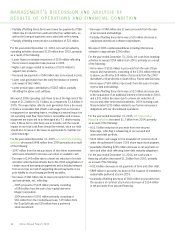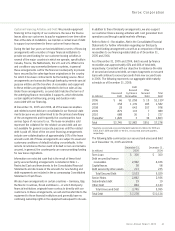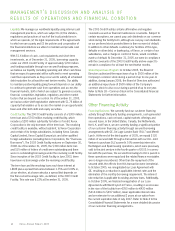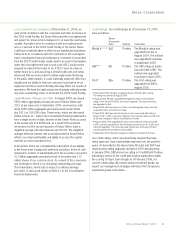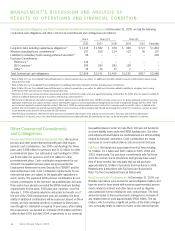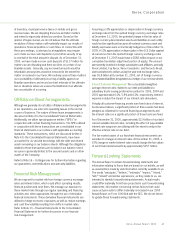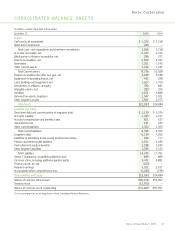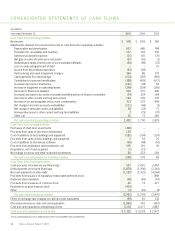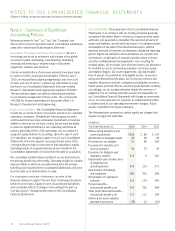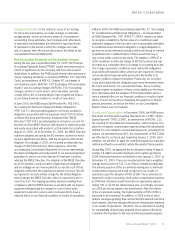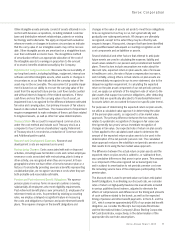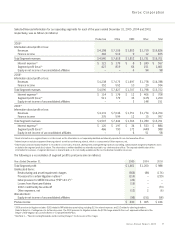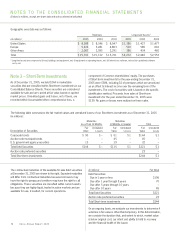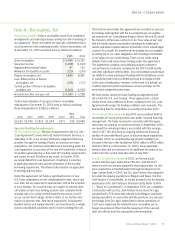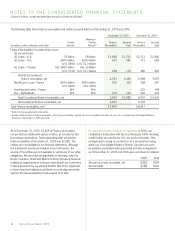Xerox 2005 Annual Report Download - page 58
Download and view the complete annual report
Please find page 58 of the 2005 Xerox annual report below. You can navigate through the pages in the report by either clicking on the pages listed below, or by using the keyword search tool below to find specific information within the annual report.
NOTES TO THE CONSOLIDATED FINANCIAL STATEMENTS
(Dollars in millions, except per-share data and unless otherwise indicated)
50
Note 1 – Summary of Significant
Accounting Policies
References herein to “we,” “us,” “our,” the “Company” and
Xerox refer to Xerox Corporation and its consolidated subsidiaries
unless the context specifically requires otherwise.
Description of Business and Basis of Presentation: We are a
technology and services enterprise and a leader in the global
document market, developing, manufacturing, marketing,
servicing and financing a complete range of document
equipment, solutions and services.
Certain reclassifications of prior-year amounts have been made
to conform to the current-year presentation. Effective July 1,
2005, we reclassified sustaining engineering costs from cost
of sales and cost of service, outsourcing and rentals to a new
line item in our Consolidated Statements of Income entitled
Research, development and engineering expenses (“R,D&E”).
This presentation aligns our external reporting presentation
to our internal management of these costs. The components
of R,D&E for all years presented are disclosed in Note 19 –
Research, Development and Engineering.
Basis of Consolidation: The Consolidated Financial Statements
include the accounts of Xerox Corporation and all of our controlled
subsidiary companies. All significant intercompany accounts
and transactions have been eliminated. Investments in business
entities in which we do not have control, but we have the ability
to exercise significant influence over operating and financial
policies (generally 20% to 50% ownership), are accounted for
using the equity method of accounting. Upon the sale of stock
of a subsidiary, we recognize a gain or loss in our Consolidated
Statements of Income equal to our proportionate share of the
corresponding increase or decrease in that subsidiary’s equity.
Operating results of acquired businesses are included in the
Consolidated Statements of Income from the date of acquisition.
We consolidate variable interest entities if we are deemed to be
the primary beneficiary of the entity.Operating results for variable
interest entities in which we aredetermined to be the primary
beneficiary are included in the Consolidated Statements of Income
from the date such determination is made.
For convenience and ease of reference, we refer to the
financial statement caption “Income from Continuing Operations
before Income Taxes, Equity Income, Discontinued Operations
and Cumulative Effect of Change in Accounting Principle” as
“pre-tax income,” throughout the notes to the Consolidated
Financial Statements.
Use of Estimates: The preparation of our Consolidated Financial
Statements, in accordance with accounting principles generally
accepted in the United States of America, requires that we make
estimates and assumptions that affect the reported amounts of
assets and liabilities, as well as the disclosure of contingent assets
and liabilities at the date of the financial statements, and the
reported amounts of revenues and expenses during the reporting
period. Significant estimates and assumptions are used for, but
not limited to: (i) allocation of revenues and fair values in leases
and other multiple-element arrangements; (ii) accounting for
residual values; (iii) economic lives of leased assets; (iv) allowance
for doubtful accounts; (v) inventory valuation; (vi) restructuring
and related charges; (vii) asset impairments; (viii) depreciable
lives of assets; (ix) useful lives of intangible assets; (x) pension
and post-retirement benefit plans; (xi) income tax reserves and
valuation allowances and (xii) contingency and litigation reserves.
Future events and their effects cannot be predicted with certainty;
accordingly, our accounting estimates require the exercise of
judgment. The accounting estimates used in the preparation of
our Consolidated Financial Statements will change as new events
occur, as more experience is acquired, as additional information
is obtained and as our operating environment changes. Actual
results could differ from those estimates.
The following table summarizes certain significant charges that
requiremanagement estimates:
(in millions)
Year Ended December 31, 2005 2004 2003
Restructuring provisions and
asset impairments $366 $ 86 $ 176
Amortization of intangible assets 42 38 36
Provisions for receivables 51 86 224
Provisions for obsolete and
excess inventory 56 73 78
Provisions for litigation and
regulatory matters 115 9 242
Depreciation and obsolescence
of equipment on
operating leases 205 210 271
Depreciation of buildings
and equipment 280 305 299
Amortization of capitalized
software 114 134 143
Pension benefits –
net periodic benefit cost 343 350 364
Other post-retirement benefits –
net periodic benefit cost 117 111 108
Deferred tax asset valuation
allowance provisions (38) 12 (16)
Xerox Annual Report 2005


